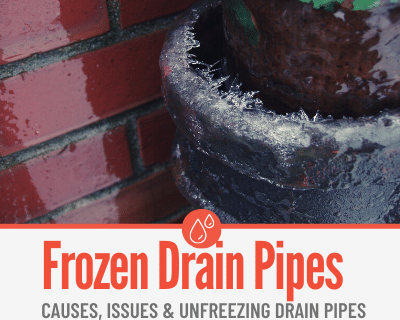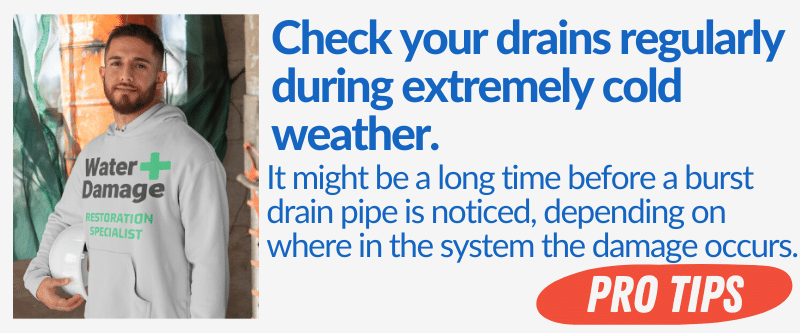Frozen Drain pipes? Trying to figure out how to thaw your frozen drain pipes?
In this guide you will learn:
- Why drain pipes freeze & Issues caused by frozen drain pipes,
- The best ways to thaw frozen drain pipes (of all types),
- What to do if your drain pipes have already burst,
- How to prevent your drain pipes from freezing.

Can Drain Pipes Freeze? – What Causes Drain Pipes to Freeze?
Yes, drain pipes, including sewer drains, can easily freeze during harsh winters. There are a few common causes for this:
1.Exposed and/or Uninsulated Drains
Any drain left exposed to outdoor environments or unheated spaces (basements/crawlspaces/walls) is in danger of freezing.
Simply put: many plumbing systems simply aren’t properly weatherized to withstand harsh winters.
As a homeowner, things to look out for include:
- Externally exposed drains
- Plumbing fixture drains extending into unheated basements, crawlspaces, or walls
- Drains in the path of cold wind/drafts, even in heated spaces
- Uninsulated drains in any of the above conditions
2.Running Water
Often, the advice given during harsh winters is to keep a trickle of water running so that incoming water supply lines don’t freeze.
Ironically, that same trickle of constantly running water can also cause drains to freeze.
How this works: as water attempts to exit the system, instead of draining quickly, it can freeze and slowly (or quickly) build up and cause a blockage or burst piping.
In addition, constantly dripping toilets and fixtures/valves are often a cause of frozen drain or sewer pipes in the winter.
It’s always a good idea to make sure these devices are functioning properly (and not running/dripping constantly) before the cold sets in.
3.Clogged/Blocked Wastewater Drains
Standing water freezes very quickly in extreme cold. A backed-up drain is a prime candidate for becoming a frozen one.
This is especially true for external gutter/sewer systems, but it applies to all drain systems.
P-traps under sinks often also freeze before other systems do, due to the standing water in them. As a homeowner, it’s critical to ensure all drain systems are clear of debris and functioning properly during cold weather.
Issues Frozen Drain Pipes Can Cause
Frozen drain pipes can lead to serious issues and cause significant damage to homes and property. They can also cause your plumbing to become nonfunctional – which can be a dangerous issue in and of itself during extreme cold weather spells.
The two most serious issues to consider though, are as follows:
- Burst piping -This is a major issue and can cause a serious water damage. Water expands when it freezes, with incredible force. Once a drain pipe has burst: the system and/or house is in danger of flooding, repair work is necessary, and the whole plumbing system might become nonfunctional very quickly.

Winterize your drain pipes now rather than later.
If a sewer or downstream pipe bursts: the system might leak large amounts of water into the house or the ground.
This can cause massive damage. In addition, if the water freezes while leaking, the ice itself can cause damage.
- Flooding – When a drain pipe freezes, outgoing water can easily back up the pipe and flood a home causing extremely large water damage. This might occur slowly or suddenly, but it will happen once a drain has become completely frozen and/or blocked. Needless to say: flooding can cause serious damage.
The flooding might not occur in the same place as the fixture being used, and it might not occur obviously.
For example, if a washer is turned on and walked away from, it might be hours before the owner notices a resulting backup/flood.
In addition, if a downstream pipe is blocked, other fixtures or plumbing connections might start leaking before the one in use does.
Frozen Drain Pipes?
Call 844-488-0570 for a Risk Free estimate from a Licensed Water Damage Restoration Specialist in your area.
We Can Help Unfreeze your Drain Pipes & Repair any Water Damage.
Frozen Drain Pipes – What To do!
For the best ways to thaw frozen drain pipes, and for more info on specific drain types: please read on.
First, we’re going to cover safety though.
What-Not-To-Do:
- Do not pour caustic “drain cleaners” or “uncloggers” into the drain. This can cause extremely toxic gases to shoot back up the pipe, which can lead to inhalation burns and/or blindness. In addition, this will not unfreeze the drain. Do not do this.
- Do not use open flame to thaw a frozen pipe. Open flame should never be used to thaw a frozen pipe. This will only lead to breaking/damaging the pipe and worsening the situation, even with metal drains/pipes. In addition, open flame poses a serious risk in most household settings.
How Long Does It Take For Frozen Drain Pipes To Thaw?
Please: be patient when trying to thaw out frozen pipes. Ice blocks can take from several minutes to several hours to melt, depending on the size of the blockage and the ambient temperature.
It is always better to wait longer rather than attempting to rush any of the below methods. Slower is better!
Can You Let Frozen Drain Pipes Thaw On Their Own?
The simple answer: yes. Summertime will eventually come around and everything will warm back up.
The real answer: the longer a drain is left frozen, the more dangerous the situation becomes. Frozen drains often burst as they become colder.
In the meantime: the plumbing system of a house is in danger of becoming nonfunctional, and the risk of flooding damage to a house increases exponentially.
Long story short: it is usually not a good idea at all to let drain pipes thaw on their own.
How To Thaw A Frozen Drain Pipe
1.Use A Space Heater To Melt Ice In Drain Pipes
This is the best way to thaw a frozen drain pipe. It is also one of the safest methods.
Please know: hairdryers and thermostatically controlled heat tape also work well for this purpose.
- To start, simply place your portable heater in a safe location near enough to the drain to warm it.
- If using a hairdryer, run the hairdryer back and forth along the length of the frozen area (this might take some time).
- If using controlled heat tape: wrap the tape around the pipe around the affected area as per the directions, and then turn it on to the appropriate setting.
For all of these methods: wait 20-30 minutes after starting, and then test the system by running/pouring water down the drain.
A simple way to tell if the drain is unfrozen is by testing whether the drain backs up or not.
A completely unfrozen drain won’t back up even under full load conditions (i.e.- fully turned-on faucets/showers).
Safety note: Please ensure that the hairdryer and/or space heater is on a low enough setting not to cause damage. If in doubt: use the lowest setting and just wait a little longer before testing.
2.Pour Warm Water Down The Drain
This is another great way to thaw frozen drain pipes. This method works well for drains that are harder to access.
- To start,heat up some water on the stove in a small pot.When the temperature gets close to 60° C (140° F).
- Remove the pot from the stove and –very slowly—pour the water down the drain.
- Wait 20-30 minutes and test the system. If necessary, repeat this procedure until the drain is clear.
Safety Note: Pouring boiling water down drains is never a good idea.PVC pipe is not designed to handle temperatures above 60° C (140° F).
In addition, pouring boiling water is a safety and health hazard.

3.Use Salt To Melt The Ice Faster
To do this, pour a tablespoon (15mL) of salt down your drain.
Pouring salt down the drain probably won’t melt the ice by itself, but it will cause it to melt faster.
Also, it helps to do this either before or in conjunction with pouring warm water down the drain (please see above).
Salt also takes time to work. When using this method, make sure and give your drains enough time to thaw (~30 minutes) before testing the system again.
4.Use A Warm Wet Towel
This is a simple and easy way to thaw a frozen but accessible drain pipe.
- Soak a towel in warm water from a sink or shower.
- Wring the towel out so that it isn’t dripping everywhere, and wrap it around the frozen drain pipe.
- Of course, this method also takes time to work, so wait 20-30 minutes (or until the towel is cold) before testing.
- If necessary, repeat this procedure until the drain unfreezes.
Also: remember to remove the towel when done.
Safety Note: the towel/water used for this purpose should be no hotter than regular tap water usually gets (48° C/120° F), so as to protect the user from serious injury.
Thawing A Frozen Washer Drain Pipe
Washer drains are notorious for freezing in the winter. Fixing them, however, is not necessarily difficult.
- Remove the washer drain tube from the drain (if possible).
- Siphon or towel up any excess standing water in the area. This will prevent excess floodwater from freezing as well.
- Use a small space heater (as outlined above) and/or pour warm water (as outlined above) down the drain.
- Give your method time to work and listen for the telltale gurgle of running water that indicates the drain is thawing.
- Repeat these steps until the drain is clear.
How To Unfreeze A Shower Drain or Frozen Bathtub Drain
A frozen shower or bathtub drain trap is a trickier proposition.
These drains are usually harder to access than others, and they might contain debris (hair, minerals, etc) that can complicate the situation.
To fix this, we recommend using a bit of chemistry and following the steps below.
- Remove the shower/bathtub drain screen or plug. Clean it of any visible debris.
- Pour ½ cup (~125 mL) of baking soda down the frozen shower drain.
- Pour one cup (~250 mL) of vinegar down the drain.
- Give this mixture time to work. The fizzing/bubbling will hopefully clear any debris that is causing a frozen clog.
- Boil one gallon (~3.8L) of water on your stove. Add ½ cup (~125mL) of salt to this and stir until the salt is completely dissolved. Let the salty water cool until it is ~ 60°C (140°F).
- Pour the warm salty water mixture into the shower drain. Wait until there is a sound of gurgling water or until the drain clears. If necessary, use more warm saltwater to clear it.
Alternative Method – If the above method doesn’t work, blowing hot air directly down the drain sometimes does.
To do this, first remove the drain screen/plug, and then aim a hairdryer down it.
This method will take some time to work, so be patient. After 10-20 minutes, try testing the drain by pouring a small amount of water down it.
If there is a gurgling noise, this means that drain is now partially cleared.
Frozen Toilet Drain
Frozen toilets and toilet drains freeze in the winter for several reasons.
The main reason, however, is that many toilet drains are located in uninsulated exterior walls.
This makes things easier from a general plumbing perspective, but it also makes toilet drains much more susceptible to freezing.
To unfreeze a toilet drain, the best method is to pour hot/salty water down the toilet (please see the above directions in this article on how to do so safely).
Keep in mind: toilets and toilet drains may contain a large amount of ice.
As such, it might be necessary to pour large amounts of hot/salty water down it.
What To Look Out For
- First, make sure your toilet supply lines aren’t also frozen. This can lead to the inability to flush even if you manage to thaw the drain pipe.
- Beware of cracking ice in toilet bowls: this can cause the bowl itself to shatter or crack.
- The toilet drains in your walls/crawlspace might be frozen because your walls are uninsulated.
- If this the case, then unfreezing the drain during extreme cold weather will only be a temporary fix unless you can find a way to continuously heat that space or to insulate the drain pipes.
Frozen Drain Pipes?
Call 844-488-0570 for a Risk Free estimate from a Licensed Water Damage Restoration Specialist in your area.
We Can Help Un-Freeze your Drain Pipes & Repair any Water Damage.
How To Prevent Drain Pipes From Freezing
1.Insulate All Drain Pipes
Proper insulation is the right answer when it comes to preventing frozen drains. It’s best to call a professional to do this, for many reasons. There are, however, some hotspots to look out for.
Key danger areas include:
P-Traps – These semi-circular fittings underneath fixtures hold standing water. Because of this, they often freeze quickly in winter months.
It is very possible to keep PVC drain pipes from freezing by adding proper insulation, and these are a great place to start.
Exposed Drains in Basements And Crawlspaces – This might seem like an obvious choice, but these are actually commonly overlooked.
It doesn’t hurt to insulate all these drains now, rather than waiting for that rare deep freeze to consider doing so.
2.Turn The Heat Up
No homeowner likes to spend large amounts on heating bills.
On the other hand, this could save even larger amounts by preventing drains from freezing during extreme weather conditions.
3.Use A Space Heater and/or Heat Tape
Portable space heaters and controllable heat tape have come a long way in the past few decades.
These items are affordable and widely available now, and they could mean the difference between functioning drains or costly repairs.
Having a few extra on hand is always a good idea.
4.Seal Holes and Cracks
Even small holes or drafty windows in basement walls can make a huge difference in internal temperatures. Take the time now to seal these off.
Also, consider insulating drafty windows.
5.Ensure Drains And Fixtures Are Functioning Properly
The longer water takes to exit a house, the higher the chance it will freeze.
This means it is very important to make sure all household drains are clear of debris/clogs, and that your plumbing fixtures are not running/dripping.
These are both very common causes of frozen drain pipes. Another common cause: gutters that drain into the sewer system.
To prevent issues from this, ensure that the gutter system is clear of debris or closed/blocked off before the cold sets in.
What To Do If Your Frozen Drain Pipes Have Burst
1.Shut Off The Water
First: turn off the water! Depending on where the burst pipe is, this could mean either turning off the water to the whole house, or simply at the fixture where the burst drain is.
For example, if the P-trap underneath a sink is broken, then only the water supply to that sink needs to be shut off.
In addition, it helps to warn others not to use said fixture until it has been fixed.
For all major leaks or broken/burst drains of an unknown nature: the main water supply to the home will need to be shut off.
To do this, you’ll need to know where the main water supply valve is located, and you’ll probably need a specialty tool or large wrench to turn it off.
2.Patch kit
For small leaks and/or cracks, it might be possible to temporarily patch the leak with a professional-grade patch kit.
However, these should only be applied after the drain pipe has been unfrozen/thawed and only while the water source/supply is turned off.
These kits are available at some hardware stores but remember: patch kits are strictly temporary measures.
3.Call A Professional
When it comes to burst and frozen pipes, this is always the best course of action.
Keep in mind: if some drains in a house are already frozen to the point of bursting, it usually means that other drains and plumbing are already at risk as well.
In addition, attempting DIY repairs under extreme or adverse weather conditions can pose a serious safety risk.
When To Call A Professional
We strongly recommend calling a professional in all of the following scenarios.
- For Burst Sewer/Drain Pipes
If any large and/or hard to access drain pipe bursts due to freezing: it’s time to call in the pros. These situations lead to serious and costly damage very quickly.
This kind of repair is very difficult to manage for the average homeowner, and it can be dangerous to even attempt during adverse weather conditions. Don’t delay: shut off the water supply and call a professional.
- For Unknown and/or Hard To Access Frozen Drains
Is your system is frozen and backing up… but you can’t figure out why or how to fix it? It’s time to call a professional.
Frozen drain pipes can be aggravating and confusing situations, but for a pro, such a repair might be a quick and simple fix.
- For Dangerous Or Risky Repairs
Safety first. If in doubt: ask for help. Frozen drains are usually the result of severe weather conditions that are dangerous enough as is.
Attempting to access frozen crawlspaces, handling frozen metal/water, and using heating/electrical devices in unusual locations are all examples of less-than-safe situations.
In addition, going without access to running water and/or risking damage to one’s home during adverse weather are outcomes best avoided.
- For Severely Frozen Drains
Occasionally, a drain can freeze up completely. If you’ve tried DIY methods to fix your drain (heating, salt, etc) and they aren’t working… it probably means you need to call a professional.
We have Water Damage Restoration Technicians that can help Find the Frozen Drain pipes, Unfreeze them safely and Repair any Water Damage done.
For Disasters of all Sizes,available in 95% of the USA
